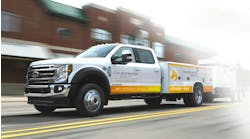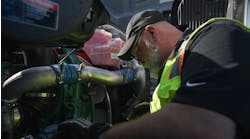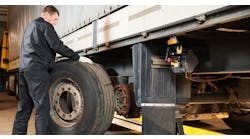Twenty years ago, online shopping was in its infancy. Amazon and eBay had only been live on the web for a few years, internet speeds were painfully slow and the general public’s view of online transactions, or ecommerce, was skeptical at best. Today, it’s hard to imagine a life without the ability to order goods with a few clicks of a mouse or taps on a touchscreen. Traditional brick-and-mortar stores have either learned to adapt by offering their own online shopping resources, or have struggled to remain in business. With advancements of technology, we have come to rely more and more heavily on ecommerce.
Ordering goods online isn’t limited to consumer products, however. In recent years, fleets have found convenience ordering parts and components online as well. Traditional parts retailers are offering more and more web-based solutions. In addition, online-only businesses are launching to compete with traditional retailers as well.
There are two basic strategies retailers use when selling parts online: business-to-consumer (B2C) and business-to-business (B2B). These terms are used more to describe the type of sales transaction, not the actual customers being served. B2C sales tend to skew towards online-only resources, while B2B sales often work with physical locations and salespeople as well as having online options.
Business-to-consumer
In their purest form, online parts retailers are based solely on the internet with no brick-and-mortar stores. Retailers such as FinditParts, an online distributor of heavy duty truck parts, trailer parts and tractor parts, are completely virtual. They don’t carry any inventory, instead relying on “an ecosystem of a supplier network,” says David Seewack, FinditParts CEO. “It's basically an amalgamation of many different types of suppliers.”
These types of retailers provide customers insight into inventory status so they know how soon they can have a critical component shipped to their shop.
“Customers [can] check the inventory status of products at Meritor’s four North America distribution facilities in Florence, Kentucky; Santa Fe Springs, California; Edmonton, Alberta; and Mississauga, Ontario,” says Christy Westrich, director of customer loyalty at Meritor, a supplier of drivetrain, mobility, braking and aftermarket solutions for commercial vehicles.
These strategies apply mainly to B2C-type sales, where parts are ordered from a website without any need to interact with another person.
“Although everybody in the trucking business is a business, business-to-consumer is more of an open parts ordering platform where you can just go to the URL and ... order directly,” says Jeff Paul, vice president of marketing at VIPAR Heavy Duty. VIPAR is a North American network of independent aftermarket truck parts distributors with more than 630 locations across the U.S., Canada, Puerto Rico and Mexico.
Business-to-business
B2B sales take that online sales platform and combine it with traditional over-the-counter brick-and-mortar methods.
“[In] a business-to-business platform, you’ll have a fleet that may have an existing relationship with a local distributor, and that distributor has a platform,” says VIPAR’s Paul. “That’s creating a technology connection between that fleet customer and the distributor. But it’s business-to-business because they already know each other.”
Online platforms such as VIPAR’s Network Workshop use this strategy to combine the convenience of ordering online with the direct sales relationship fleets have with distributors. Paul says one advantage to working with a distributor is that fleets will still have the option of speaking with an actual person who has extensive knowledge about truck parts and components. If the fleet is unsure about what exact part to look for, this resource is available to help.
While light duty vehicle parts are easier to look up by vehicle make, model and year, heavy duty vehicles are far more unique and customizable. This presents more challenges to confirm exactly what part is needed for a specific vehicle.
“On the commercial vehicle side, [fleets] may use a B2C storefront to buy ... some item that isn’t very complex,” Paul says. “But most of the product in our space, you need to really know what you’re looking for.”
Some companies take a more combined approach to bridge the gap between the traditional brick-and-mortar store and online parts ordering, to help ease customers into the world of online parts retail.
“It is increasingly important for online parts providers to deliver an in-person like experience through their online platforms,” says Meritor’s Westrich. “On MeritorPartsXpress.com, customers can tap into the vast product knowledge of the people who manufacture their parts, from the convenience of their parts counters.”
Still others take it a step further with staff dedicated to each fleet they work with, having intimate knowledge of each one’s needs.
“We have a dedicated individual for each and every one of our customers,” says Pauline Schuster, director of marketing services and product management at Imperial Supplies. “That means the customer will have an individual that knows their business inside and out, understands their purchases, understands their unique issues within their maintenance shop and can help them solve problems on the fly.”
Founded in 1958, Imperial Supplies is a national distributor of maintenance products that services customers through a nationwide network of regional distribution centers.
Challenges with online parts ordering
Whether it’s B2C or B2B, online parts ordering is not without its challenges. Logistics concerns, product expectations and customer service keep many customers loyal to traditional brick-and-mortar parts stores. Online retailers are working hard to overcome these challenges and prove to customers that ordering parts online can be every bit as good... and maybe even better.
Logistics
One major challenge when it comes to ordering parts online is the logistics of actually receiving the part. FinditParts’ Seewack describes shipping as “the Achilles heel” of online purchases.
When buying from a brick-and-mortar store, as long as the product a fleet needs is in stock it can be obtained as quickly as someone can get to the store to retrieve it. With online ordering, the part needs to be shipped to the shop, typically requiring several business days (or more, for larger/heavier parts). This can become costly when a fleet has a truck down and can’t get the parts needed to fix it right away. That’s why online retailers are working to make shipping as fast and painless as possible.
“Our orders are shipped directly to the customer, typically within a day,” says Nicole AlBoushi, ecommerce director at Imperial Supplies. “It's dependent on where our distribution centers are. We have ... 22 distribution centers across the United States, so that one- to two-day shipping is dependent on how close you are to that distribution center. We do our best, go above and beyond, to make sure that those orders get out the door and to the customer’s shop as quickly as possible.”
Seewack says FinditParts is working towards standard two-day shipping, “and ultimately same-day delivery in a geographic location,” he says.
The online retailer also offers customers insight into each shipment by providing tracking information and delivery confirmation, Seewack adds.
Meritor’s Westrich confirms that in addition to being able to view inventory status, customers of MeritorPartsXpress.com can have available parts shipped to them within 24 hours.
While availability with online shipping is still not as immediate as with in-store pickup (assuming the part is in stock), it is getting closer and closer to that benchmark.
Product expectation
Another challenge when it comes to ordering parts online is product expectation. It can be difficult for a fleet to know exactly what part they are purchasing without being able to see and touch it in person. Online retailers are working to make a more seamless experience in this regard to help customers get a better idea what they’re looking at.
“Customers are far more likely to order parts and products they are familiar with online, while purchasing less familiar parts in traditional storefronts offering trained sales personnel,” Westrich says. “Online parts providers must continuously develop new and improved ways to bridge the gap between a hands-on experience and buying online by providing a knowledge-based experience within their ecommerce platform.”
Westrich says Meritor is bridging that gap by offering 360-degree product images for online customers to get the look and feel of parts. Customers can also use Meritor’s Visual Search tool to view a dynamic picture of an entire vehicle system. For example, the website offers a view of an entire axle, with over 100 components, allowing the customer to then drill down to the specific brake shoe on the axle.
Customer service
A major concern for fleets when it comes to ordering online is customer service, and the potential lack of human interaction with a company representative during the transaction. Customers may worry there will be difficulty expressing concerns about any issues with the product, or additional challenges with returning the purchase if necessary.
Michelle Kopecki, marketing manager at Imperial Supplies, says the company spends a lot of time with their customers to understand what challenges they have. She says the number one concern is utilizing online tools. Because of that potential frustration, Kopecki advises the Imperial Supplies team has worked hard to ease those concerns by offering the best customer service they can.
The reality is most online parts retailers provide a human touch when it comes to customer service. The majority of the time, customers are not left to fend for themselves with frustrating automated recordings or non-responsive email addresses.
“Self-service tools have become increasingly advanced, and customers can trust that they will receive the same level of post-order support that they experience in traditional face-to-face transactions,” Westrich says.
Seewack adds FinditParts employs customer service agents that can handle requests multiple ways. To reach a company representative, customers can submit an email, a trouble ticket through the website, or a phone call for product.
As with ordering consumer goods online, sometimes fleets will receive a part that is not what they expected. Whether the wrong part was ordered, the wrong part was shipped or there was a manufacturing defect, the part will need to be returned for an exchange or refund. When purchasing from a brick-and-mortar store, returns are as simple as taking the part back to the store. With ordering from an online-only vendor, fleets may have to consider the reverse logistics.
Online parts retailers attempt to make this process as painless as possible by providing generous return policies and allowing customers to make returns without having to contact customer service, unless they wish to.
According to Kopecky, Imperial Supplies, for example, offers a “100-percent satisfaction guarantee.” Fleets can work with their advisors to help determine what is needed. “If you ordered the wrong part, as a customer, we're not going to shame you,” she says. “We just want to make sure that you get what you need and that you get it as quickly as possible. We're going to help you return that particular part and make sure that you get the parts that you need.”
Advantages of online parts ordering
Convenience, reduced downtime and greater product selection are a few advantages fleets can expect when shopping for parts and components online.
“Ordering parts online provides the convenience of locating and purchasing hundreds of thousands of parts from global warehouses without having to visit a traditional storefront location,” says Meritor’s Westrich.
Westrich adds that, with virtual retailing, online customers are provided a 24-hour storefront, available nearly anywhere via mobile devices.
The advantages of this method of purchasing parts become especially apparent when considering vehicle downtime while waiting for someone to retrieve parts from a physical store, versus having them shipped directly to the shop.
“There's a real cost, when you take a look at sending a technician out to a brick-and-mortar [store], says Imperial Supplies’ Kopecky. “If you need to put that person in a truck, send them three miles, five miles, 20 miles down the road, wait for [the parts] at a will-call and then to return, that's lost time.” Kopecky adds that if fleets order online, a technician doesn’t need to leave the shop; he or she can remain there fixing the down vehicle to get it back on the road faster.
Another advantage to purchasing through a website is that it’s a virtual one-stop shopping experience. While a brick-and-mortar store may not have everything a fleet needs in stock, a parts website typically draws from a wide range of suppliers or distributors, and will therefore have a much larger available selection.
“Fleets, or anyone buying parts traditionally, may take a bucket of parts and go to a [store], and they may or may not have what they're looking for,” FinditParts’ Seewack says. “Then they have to figure out where else [they are] going to go [to find the part]. Then they go to that place, and they either have it or they don't.”
On the other hand, online parts suppliers have a wide range of parts available. Seewack says FinditParts.com has 9.5 million parts, and each clearly has an identifiable supplier.
Not only do online retailers provide access to more parts, they provide that access from anywhere with an internet connection or cell phone reception. Many online parts sellers have mobile apps and mobile-friendly websites, in addition to their standard computer browser websites.
Imperial Supplies’ AlBoushi notes the company has a mobile app and a mobile website. A customer can open the mobile app, press ‘call’ or ‘email’ and the phone call or email will go directly to the fleet’s account manager. The app also contains a scanning feature that allows customers to scan the barcode of a part they need, enter the quantity and place the order.
“We are seeing a huge trend continuing over the past three years of our customers purchasing on mobile,” AlBoushi says. “We attribute a lot of that to the scanner; that quick and easy way to reorder the product that you're looking for.”
Ease of reordering product is made simple with most online parts retailers. VIPAR’s Paul suggests for the most part, fleets prefer to rely on distributors to handle their stock to avoid having assets tied up in spare parts that aren’t needed right away. However, there are parts that fleets know they will use and need to have on-hand. For those parts that are used often - filters and brake pads, for instance - there is a convenience factor added by ordering online.
Fleets can build orders over time and save them to their customer profile on the website, Paul says. When the fleet needs to order those same parts again, they can simply log in to their profile, access the saved order, modify it if needed, and place the order from there.
AlBoushi says Imperial Supplies enhances that process one step further by offering customers an automatic reorder option within their profile, with options to choose frequency and quantity.
Selecting an online parts provider
There are myriad options when it comes to purchasing parts online. To choose the best online parts provider for a fleet’s specific needs, it can help to know what to look for, such as good customer service, positive ratings and the quality of parts provided.
“Focus on the customer,” says Meritor’s Westrich, of what to look for in an online parts retailer. “Whether that be on-time delivery of products, parts purchasing guidance or the ability to provide the same level of customer service online as expected in a storefront experience.”
Along those same lines of customer service, Imperial Supplies’ AlBoushi adds that fleets should ensure the retailer offers the product they need, as well as the tools they need to easily find it.
FinditParts’ Seewack says fleets should also be aware of the company’s reputation. Reading reviews from previous customers can be very helpful.
“Reviews tell a lot,” he says. “Word of mouth tells a lot, and [so does] experience. Sometimes, you have to dip your toe in a couple of waters, and then, I think, the results prove themselves.”
Another important factor to look at is the quality of parts the retailer offers. VIPAR’s Paul says fleets should make sure they will get what they expect from an online retailer. “Are they carrying premium branded product?” he asks. “Are you getting the products that have been built for the application? That should be one of the first and foremost [criteria], because when you think about repairing trucks, you’re worried about safety and uptime.”
Conclusion
Ordering parts online is already common practice for some fleets, but to others, it may seem like a radical departure from the norm. While it may not be right for every fleet, online parts procurement can improve shop efficiency in some cases.
Just as online ordering has become more commonplace for everyday consumer purchases, ecommerce is positioned to gain marketshare compared to traditional purchasing methods for commercial truck parts as well. The main challenge for fleets looking to join in this market trend will be deciding which online supplier meets their needs and helps improve their uptime.




